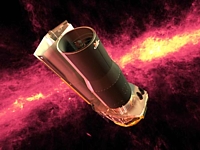![]() space astronomy
space astronomy
Space telescopes, which should really be called space observatories, are devices that are in orbit around the Earth, beyond the atmosphere. This allows them to achieve high-resolution observations that in some cases are impossible to achieve from ground-based observatories, subject to atmospheric influence. These telescopes have a series of instruments to analyze the Universe, although some specialize only in certain ranges (e.g. the telescope Hubble in visual, Chandra in X-rays). These devices represent a huge step in modern astronomy, where thanks to advances in astronautics, it has been possible to put these true scientific laboratories into orbit, which allow professional astronomy to have images of the most remote sectors of the Universe.
 Hubble Space Telescope
Hubble Space Telescope
The Hubble Space Telescope (HST) is a device specialized in astronomical observations in the visible range, launched in orbit in 1990 as a joint project between NASA and ESA. It has the enormous advantage of not being affected by the atmosphere, since it is in Earth orbit at 593 km high and therefore can obtain data that is very difficult or impossible for terrestrial observatories. Hubble has made important astronomical discoveries as well as provided beautiful images of celestial objects, the latter being the main reason for its admiration around the world.
Spitzer Space Telescope
 The Spitzer Space Telescope (SST) is a device that specializes in astronomical observations in the infrared range, launched into orbit in 2003 as a NASA project. This telescope seeks to study cold objects emitting in infrared, a spectrum range that is significantly absorbed by the Earth's atmosphere and therefore necessary to study from other conditions, such as those provided by Spitzer from space, orbiting the Earth. Spitzer, like Hubble, has provided plenty of data and images of vast regions of the Universe.
The Spitzer Space Telescope (SST) is a device that specializes in astronomical observations in the infrared range, launched into orbit in 2003 as a NASA project. This telescope seeks to study cold objects emitting in infrared, a spectrum range that is significantly absorbed by the Earth's atmosphere and therefore necessary to study from other conditions, such as those provided by Spitzer from space, orbiting the Earth. Spitzer, like Hubble, has provided plenty of data and images of vast regions of the Universe.

